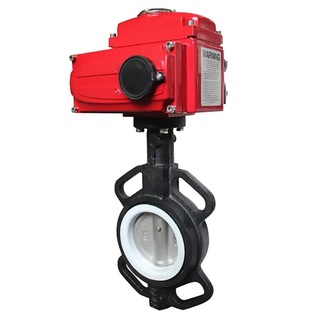We are a leading control valve manufacturer in China, delivering high-quality valves and control actuators customized to meet a wide range of industrial requirements.
Electric butterfly control valves play a crucial role in modern industrial automation. As integral components of fluid control systems, they regulate the flow of liquids and gases with precision and reliability. Their performance directly impacts process efficiency, safety, and uptime across industries such as oil and gas, chemical processing, water treatment, and HVAC.
When these valves malfunction, the consequences can include costly downtime, safety risks, and production delays. That’s why maintenance teams must be well-versed in identifying and resolving issues swiftly. This guide explores six of the most common faults encountered in electric butterfly control valves, their root causes, and practical troubleshooting techniques to restore reliable operation.
Why Electric Butterfly Valves Matter
Electric butterfly valves are widely adopted due to their:
- Compact design
- Fast response times
- Low maintenance needs
- Precise flow control
They are suitable for a wide range of flow media and operating environments. However, like all mechanical systems, they are susceptible to wear, environmental factors, and control circuit failures. A systematic troubleshooting approach is essential to resolve faults and minimize downtime.
6 Common Electric Butterfly Valve Faults and Solutions
1. Motor Does Not Start
Symptoms: The valve fails to respond to control commands; motor remains inactive.
Possible Causes:
- Disconnected power lines
- Faulty control wiring
- Malfunction in torque or stroke control mechanism
Troubleshooting:
- Inspect and reconnect power lines or replace damaged sections.
- Check the control line for continuity and proper terminal connections.
- Test the stroke/torque controller and repair or recalibrate as needed.
2. Output Shaft Rotates in the Wrong Direction
Symptoms: Valve opens when it should close, or vice versa.
Possible Cause:
- Incorrect phase sequence in the power supply
Troubleshooting:
- Swap any two phases of the power supply to correct the rotation direction.
3. Motor Overheating
Symptoms: Motor becomes abnormally hot; may trigger thermal protection shutdown.
Possible Causes:
- Continuous long-term operation
- Phase loss or imbalance in power supply
Troubleshooting:
- Allow the motor to cool and avoid extended continuous operation.
- Check for phase disconnection; ensure all wiring is secure and functional.
4. Motor Stops Unexpectedly
Symptoms: Motor halts during operation without completing the valve stroke.
Possible Causes:
- Mechanical obstruction or valve damage
- Excessive torque triggering overload protection
Troubleshooting:
- Inspect the valve body for foreign objects or internal damage.
- Adjust torque settings to better align with process demands while remaining within safe limits.
5. Motor Does Not Stop After Valve Reaches Position
Symptoms: Motor continues running despite the valve reaching its end travel position.
Possible Causes:
- Faulty travel limit switch or torque mechanism
- Misadjusted travel control settings
Troubleshooting:
- Inspect travel and torque limit switches for wear or misalignment.
- Recalibrate the limit switches based on valve specifications.
6. No Remote Valve Position Feedback
Symptoms: Control system shows no feedback or incorrect position status.
Possible Causes:
- Loose set screw on potentiometer gear
- Faulty position feedback sensor (e.g., potentiometer)
Troubleshooting:
- Tighten the set screw to restore gear engagement.
- Replace the potentiometer if it's defective.
Proactive Maintenance Tips for Long-Term Reliability
To avoid unexpected valve failures, implement the following preventive strategies:
1. Routine Inspections
- Regularly examine all wiring, terminals, and mechanical linkages.
- Check for signs of corrosion, overheating, or loose fittings.
2. Accurate Calibration
- Periodically adjust torque and stroke settings.
- Use calibration tools to verify alignment with system specs.
3. Maintain a Clean Operating Environment
- Keep the valve and actuator area free from dust, oil, and moisture.
- Install protective covers in corrosive or outdoor environments.
4. Scheduled Maintenance Intervals
- Replace aging or worn components before failure occurs.
- Maintain a logbook to track maintenance history and fault patterns.
5. Training for Operators and Technicians
- Ensure personnel understand valve functions and control logic.
- Provide detailed manuals and quick-reference fault guides.
Advanced Monitoring and Diagnostic Solutions
Leveraging modern technology can significantly improve reliability and reduce manual intervention:
IoT-Enabled Sensors
- Monitor temperature, torque, and valve position in real time.
- Provide alerts when parameters exceed safe thresholds.
Predictive Analytics
- Analyze operational data to forecast potential failures.
- Transition from reactive to predictive maintenance strategies.
Remote Monitoring
- Integrate with SCADA or cloud platforms for off-site control and diagnostics.
- Reduce response times and enable centralized management.
Conclusion
Electric butterfly control valves are indispensable for modern process automation. Understanding their common fault modes—and knowing how to diagnose and fix them—can save time, reduce costs, and ensure uninterrupted production.
By combining regular maintenance, technician training, and advanced monitoring systems, you can extend the service life of your valves and boost the overall efficiency and safety of your operations.
Invest in quality components, smart maintenance practices, and professional support—your process reliability depends on it. Know more about Google SEO Directory





Comments